Living Heritage in the Urban Landscape. Case Study of the Budapest World Heritage Site Andrássy Avenue
Abstract
1. Introduction
1.1. Urban Allées–from Garden Art to Urban Landscape Architecture—A Literature Review
1.2. Andrássy Avenue and Its Importance in the Urban Landscape
2. Materials and Methods
2.1. Site Survey of the Urban Avenue as a Linear Green Open Space
2.2. Dendrological and Dendrometrical Survey
3. Results of Site Analyses and Tree Survey
3.1. Andrássy’s Urban Character and Functions
3.2. Green System and Habitat Analyses along Andrássy Avenue
3.2.1. Urban Habitat and Planting Places
3.2.2. Species Uniformity/Diversity
3.2.3. Age Uniformity
3.2.4. Condition of Roots, Root Collars and Tree Pits
3.2.5. Trunks’ Condition
3.2.6. Crowns’ Condition
3.2.7. Correlation of Vitality
4. Discussion
5. Conclusions
Author Contributions
Funding
Acknowledgments
Conflicts of Interest
Appendix A
References
- László, S. Hogyan épült Budapest? (1870-1930) (How Budapest’s Building Went on?); Fővárosi Közmunkák Tanácsa (Council of Budapest Public Works): Budapest, Hungary, 1931; pp. 162–171. [Google Scholar]
- Johnston, M. Trees in Towns and Cities. A History of British Urban Arboriculture; Oxbow Books: Oxford, UK, 2015; p. 41. [Google Scholar]
- Benevolo, L. A Város Európa Történetében. (La Citta Nella Storia D’Europa); Atlantisz Publisher: Budapest, Hungary, 1994; p. 165. [Google Scholar]
- Zachariasz, A. Development of The System of the Green Areas of Krakow from The Nineteenth Century to The Present, In The Context of Model Solutions. Proc. Iop Conf. Ser. Mater. Sci. Eng. 2019, 471, 112097. [Google Scholar] [CrossRef]
- Lawrence, H.W. From Private Allée to Public Shade Tree: Historic Roots of the Urban Forest. Arnoldia 1997, 57, 2. Available online: http://www.jstor.org/stable/42954514 (accessed on 14 April 2021).
- Lawrence, H.W. City Trees. A Historical Geography from the Renaissance through the Nineteenth Century; University of Virginia Press: Charlottesville, VA, USA; London, UK, 2008; pp. 57–63. [Google Scholar]
- Stilgenbauer, J.; McBride, J.R. Reconstruction of Urban Forests in Hamburg and Dresden after World War II. Landsc. J. 2010, 29, 144–160. Available online: www.jstor.org/stable/43323881 (accessed on 14 April 2021).
- Jarrassé, D. Grammaire des Jardins Parisiens; Parigramme: Paris, France, 2007. [Google Scholar]
- Bandarin, F.; van Oers, R. The Historic Urban Landscape-Managing Heritage in an Urban Century; John Wiley & Sons: Hoboken, NJ, USA, 2012; pp. 10–13. [Google Scholar]
- Liu, T.; Butler, R.J.; Zhang, C. Evaluation of public perceptions of authenticity of urban heritage under the conservation paradigm of Historic Urban Landscape—A case study of the Five Avenues Historic District in Tianjin, China. J. Archit. Conserv. 2019, 25, 228–251. [Google Scholar] [CrossRef]
- Andrássy, C.G. (1823-1890) Hungarian Statesman, Hungarian Prime Minister in the Austro-Hungarian Kingdom in 1867-1879. Lived in Paris after the Suppression of the 1848-49 Freedoms War, Where–among Others–the Gracious Development of the Champs Elysée Impressed him. In: Kovács Emőke: “A szép akasztott”–Id. Andrássy Gyula élete. Ujkor.hu 2017. 02. 07. Available online: https://ujkor.hu/content/a-szep-akasztott-id-andrassy-gyula-elete (accessed on 10 April 2021).
- Palonen, E. The City-Text in Post-Communist Budapest: Street Names, Memorials, and the Politics of Commemoration. GeoJournal 2008, 73, 219–230. Available online: https://www.researchgate.net/publication/225587665_The_City-Text_in_Post-Communist_Budapest_Street_Names_Memorials_and_the_Politics_of_Commemoration (accessed on 7 April 2021). [CrossRef]
- Harloe, M. Cities in the Transition. In Cities After Socialism; Andrusz, G., Harloe, M., Szelenyi, I., Eds.; Wiley-Blackwell: Oxford, UK, 1996; pp. 1–29. [Google Scholar]
- Light, D. Street names in Bucharest, 1990–1997: Exploring the modern historical geographies of post-socialist change. J. Hist. Geogr. 2004, 30, 154–172. [Google Scholar] [CrossRef]
- Creţan, R.; Matthews, W.P. Popular responses to city-text changes: Street naming and the politics of practicality in a post-socialist martyr city. Area 2016, 48, 92–102. [Google Scholar] [CrossRef]
- Tucker, E.L. Renaming Capital Street: Competing Visions of the Past in Post-Communist Warsaw. City Soc. 1998, 10, 223–244. [Google Scholar] [CrossRef][Green Version]
- Preisich, G. Budapest Városépítésének Története II. A Kiegyezéstől a Tanácsköztársaságig; History of Budapest Urban Development; Műszaki Könyvkiadó: Budapest, Hungary, 1964; pp. 1867–1919. [Google Scholar]
- Szilágyi, K. Ethical and Aesthetic Aspects in the Renewal of Historic Allées. Hist. Environ. Policy Pract. 2014, 5, 3–16. [Google Scholar] [CrossRef]
- Szaller, V. Az Andrássy út; The Andrássy Avenue; FŐKERT Zrt. 2010. Available online: www.fokert.hu/dokumentumok/fasorok/andrassy.pdf (accessed on 19 April 2021).
- Mőcsényi, M. Band II. kötet. Vélemény a Népköztársaság úti platánfákról (Professional opinion to the plane trees of Népköztársaság út). Ph.D. Thesis, Hungarian Academy of Sciences, Budapest, Hungary, 1993; pp. 483–487. [Google Scholar]
- United Nations Educational, Scientific and Cultural Organisation. Budapest, including the Banks of the Danube, the Buda Castle Quarter and Andrássy Avenue. In Convention Concerning the Protection of the World Cultural and Natural Heritage; World Heritage Committee: Baku, Azerbaijan, 2019; Available online: https://whc.unesco.org/archive/2019/whc19-43com-18-en.pdf (accessed on 25 February 2021).
- Vesalon, L.; Cretan, R. “Little Vienna” or “European Avant-Guard City”? Branding Narratives in a Romanian City. J. Urban Reg. Anal. 2019, 11, 19–34. [Google Scholar] [CrossRef]
- Wilson, E.H. Aristocrats of the Trees by Ernest Henry Wilson; Dover Publications Inc.: Mineola, NY, USA, 1838; p. 1. [Google Scholar]
- Sanders, J. Defining and Measuring Success in the Urban Forest. Rutgers 2012. [Google Scholar] [CrossRef]
- Goodwin, D. The Urban Tree; Routledge: Abingdon, UK, 2017; pp. 5–17. Available online: https://books.google.hu/books?id=ruyfDgAAQBAJ&printsec=frontcover&dq=duncan+goodwin&hl=en&sa=X&redir_esc=y#v=onepage&q=duncan%20goodwin&f=false (accessed on 5 March 2021).
- Roloff, A. Urban Tree Management: For the Sustainable Development of Green Cities; John Wiley & Sons: Hoboken, NJ, USA, 2016; pp. 17–18, 36–45. Available online: https://books.google.hu/books?id=h4ibCgAAQBAJ&printsec=frontcover&dq=andreas+roloff&hl=en&sa=X&redir_esc=y#v=onepage&q=andreas%20roloff&f=false (accessed on 5 March 2021).
- Szaller, V. Útmutató a Vizuális és Műszeres Favizsgálatok Elvégzéséhez és Dokumentálásához; Magyar Faápolók Egyesülete: Kiskunhalas, Hungary, 2017. [Google Scholar]
- Mattheck, C. Design in Nature: Learning from Trees; Springer: Berlin/Heidelberg, Germany, 1998; pp. 1–4. [Google Scholar] [CrossRef]
- Mattheck, C. Updated Field Guide for Visual Tree Assessment; Forschungszentrum Karlsruhe: Karlsruhe, Germany, 2007. [Google Scholar]
- Lukács, Z. Faápolás; Garden Kft.: Budapest, Hungary, 2020; pp. 79–210. [Google Scholar]
- Comité Champs-Élysées. Le Pavillon de l’Arsenal avec le Comité Champs-Élysées. Étude réalisée par Philippe Chiambaretta. In Champs-Élysées Histoire & Perspectives; PCA-STREAM: Février, France, 2020. [Google Scholar]
- Morgenroth, J.; Ostberg, J.; van den Bosch, K.; Cecil, K. Urban Tree Diversity–Taking Stock and Looking Ahead. Urban For. Urban Green. 2016, 15, 1–5. [Google Scholar] [CrossRef]
- Foresman, T.W.; Pickett, S.T.; Zipperer, W.C. Methods for spatial and temporal land use and 295 land cover assessment for urban ecosystems and application in the greater Baltimore-Chesapeake 296 region. Urban Ecosyst. 1997, 1, 201–216. [Google Scholar] [CrossRef]
- MacDonagh, P. How “Clean and Simple” Becomes “Dead and Gone”. Green Infrastructure for Your Community. February 16, 2015/L. Peter MacDonagh. Available online: https://www.deeproot.com/blog/blog-entries/how-clean-and-simple-becomes-dead-and-gone (accessed on 14 April 2021).
- Marot, N.; Golobič, M.; Müller, B. Green Infrastructure in Central, Eastern and South Eastern Europe: A Universal Solution to Current Environmental and Spatial Challenges? Urbani Izziv 2015, 26, S1–S12. Available online: www.jstor.org/stable/24920943 (accessed on 14 April 2021).
- Hüttl, R.F.; David, K.; Schneider, B.U. Historic Gardens and Climate Change; Insight, Desiderata and Recommendations; Open access, De Gruyter; Berlin-Brandenburgische Akademie der Wissenschaften: Berlin, Germany, 2019. [Google Scholar]
- Radó, D.T. Budapest Zöldinfrastruktúra Fejlesztési és Fenntartási Akcióterve (Budapest Green Infrastructure and Management Action Plan); Accepted by the Budapest Municipality General Meeting decision, 664/2021. (III.31.) Corresponding author was part of the professional research and authors’ team; Budapest Municipality: Budapest, Hungary, 2021.

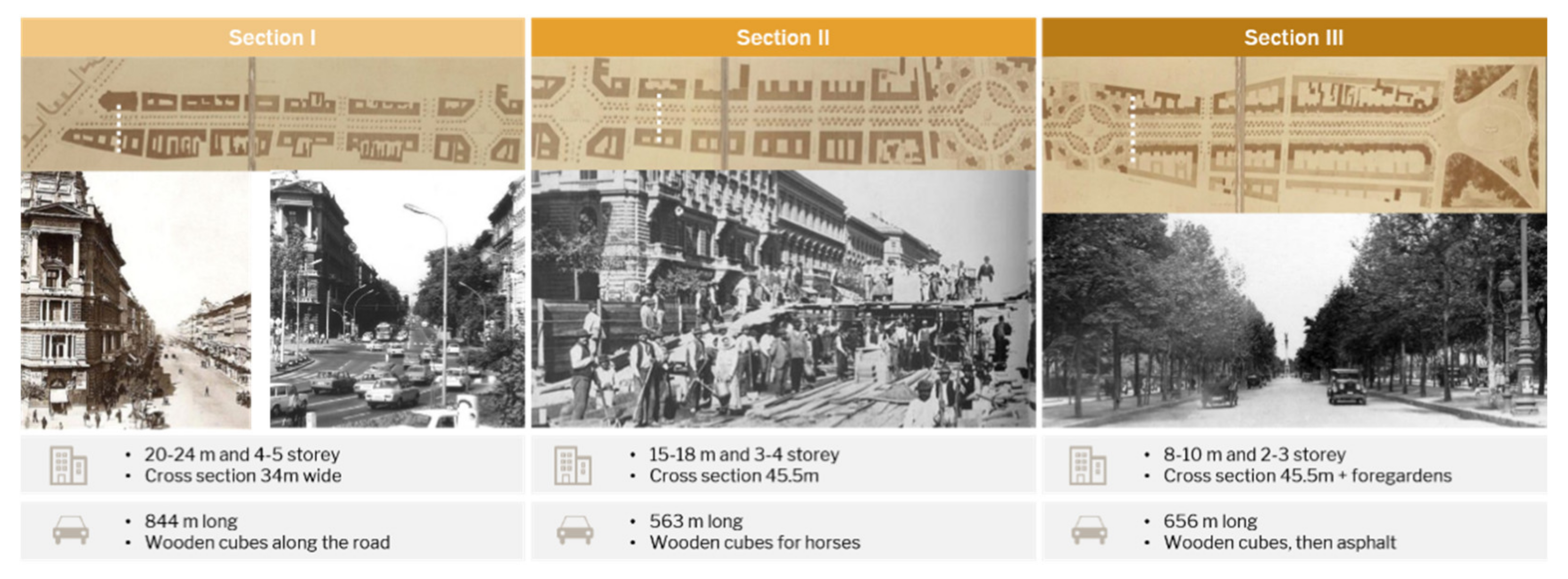


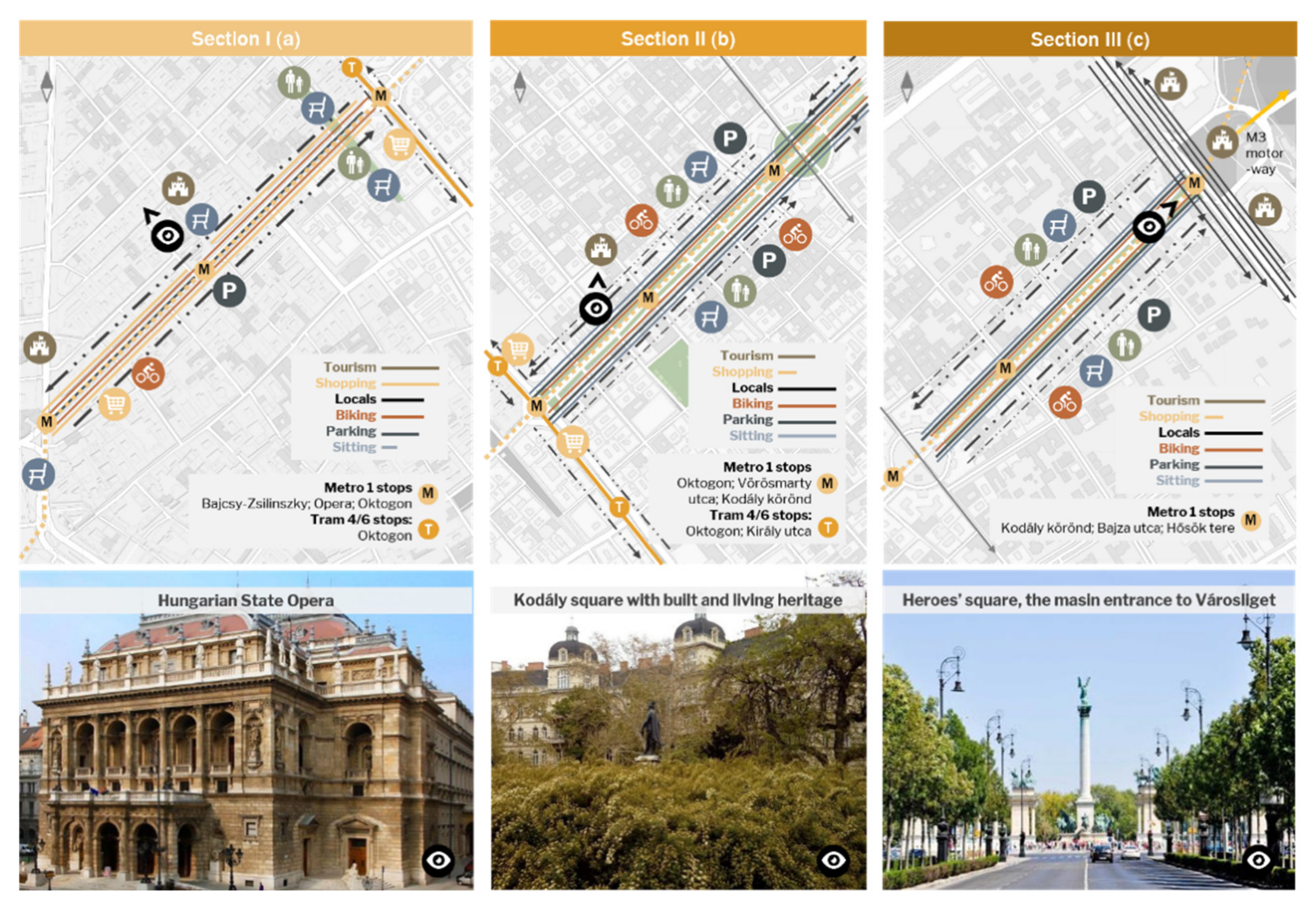
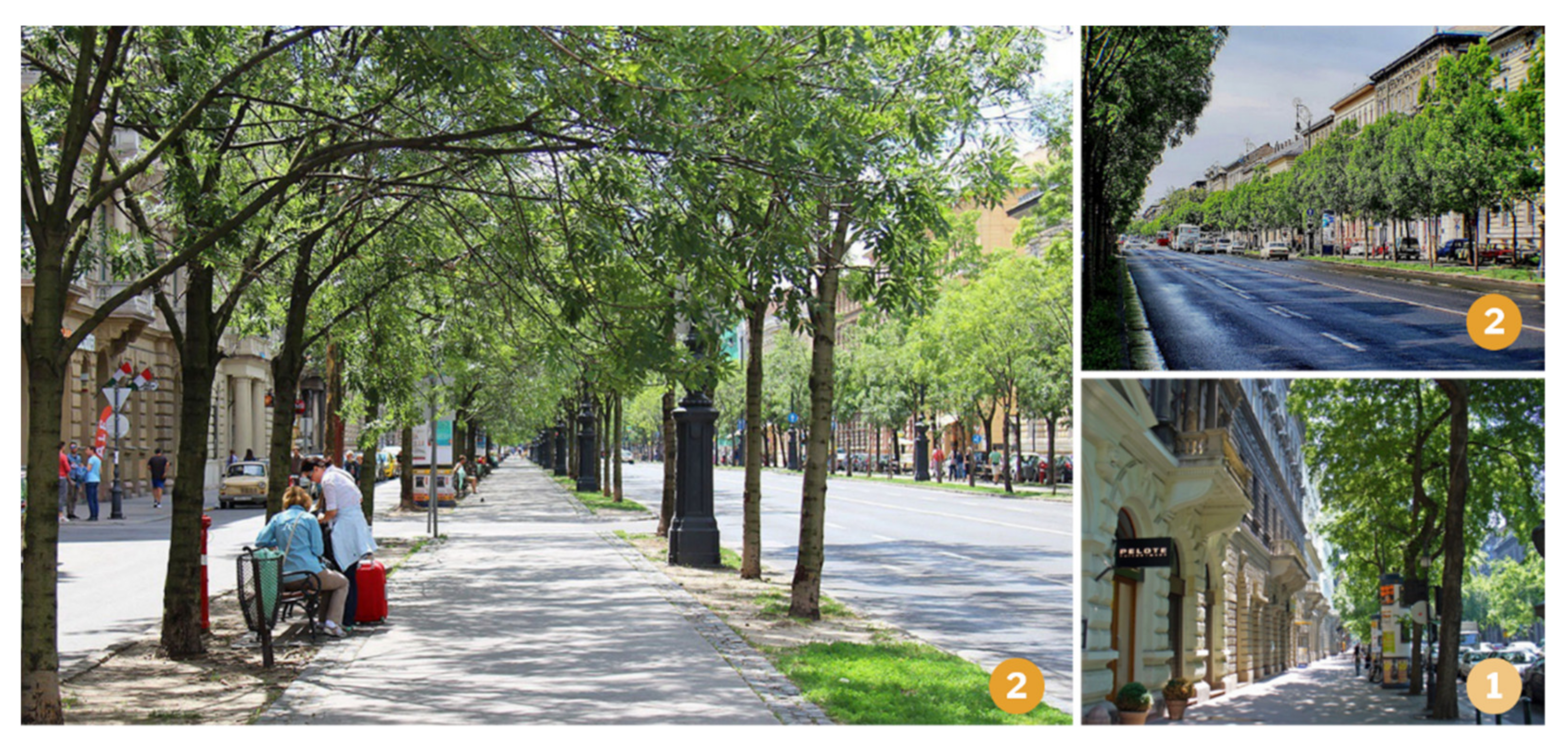
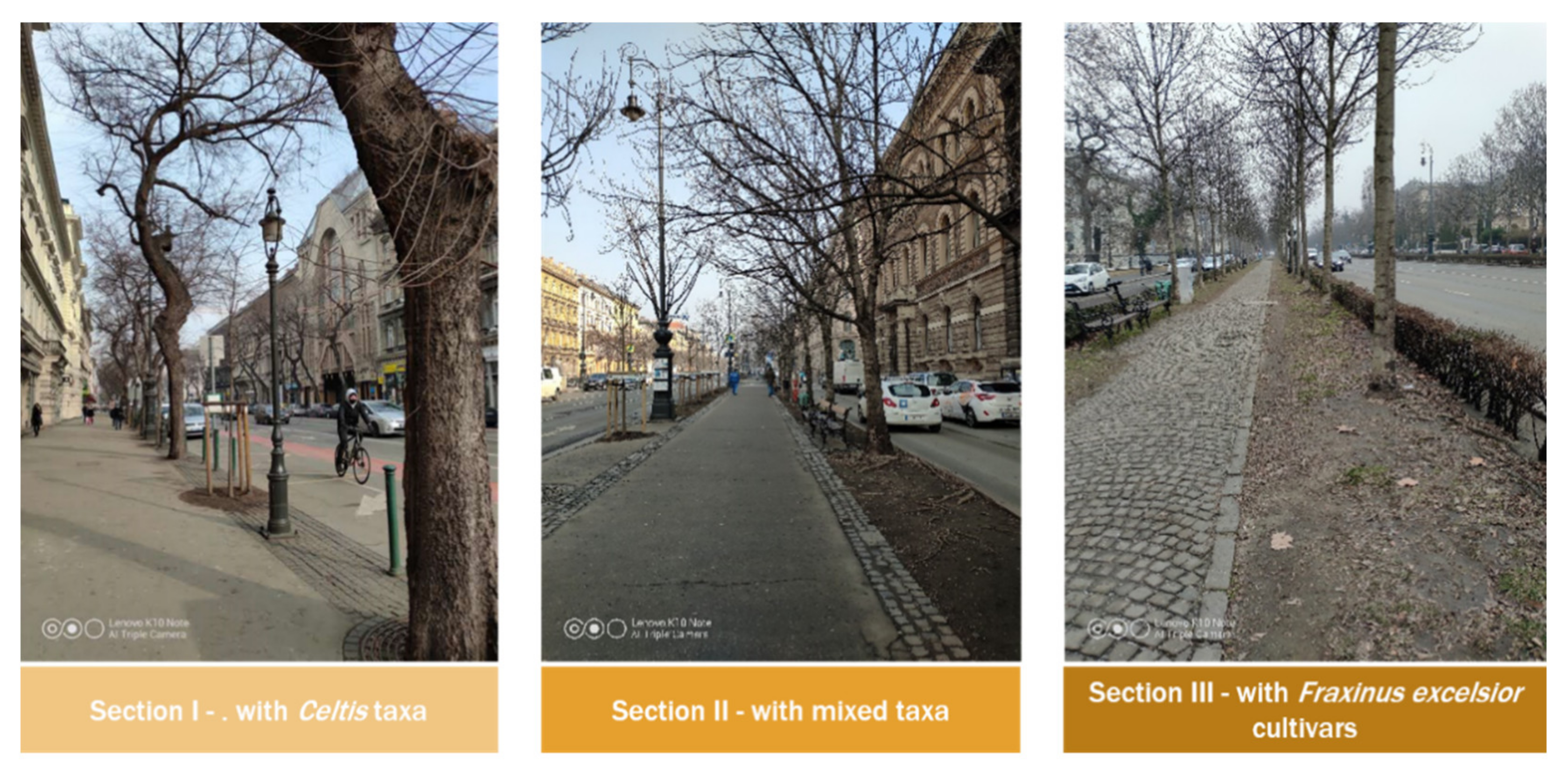
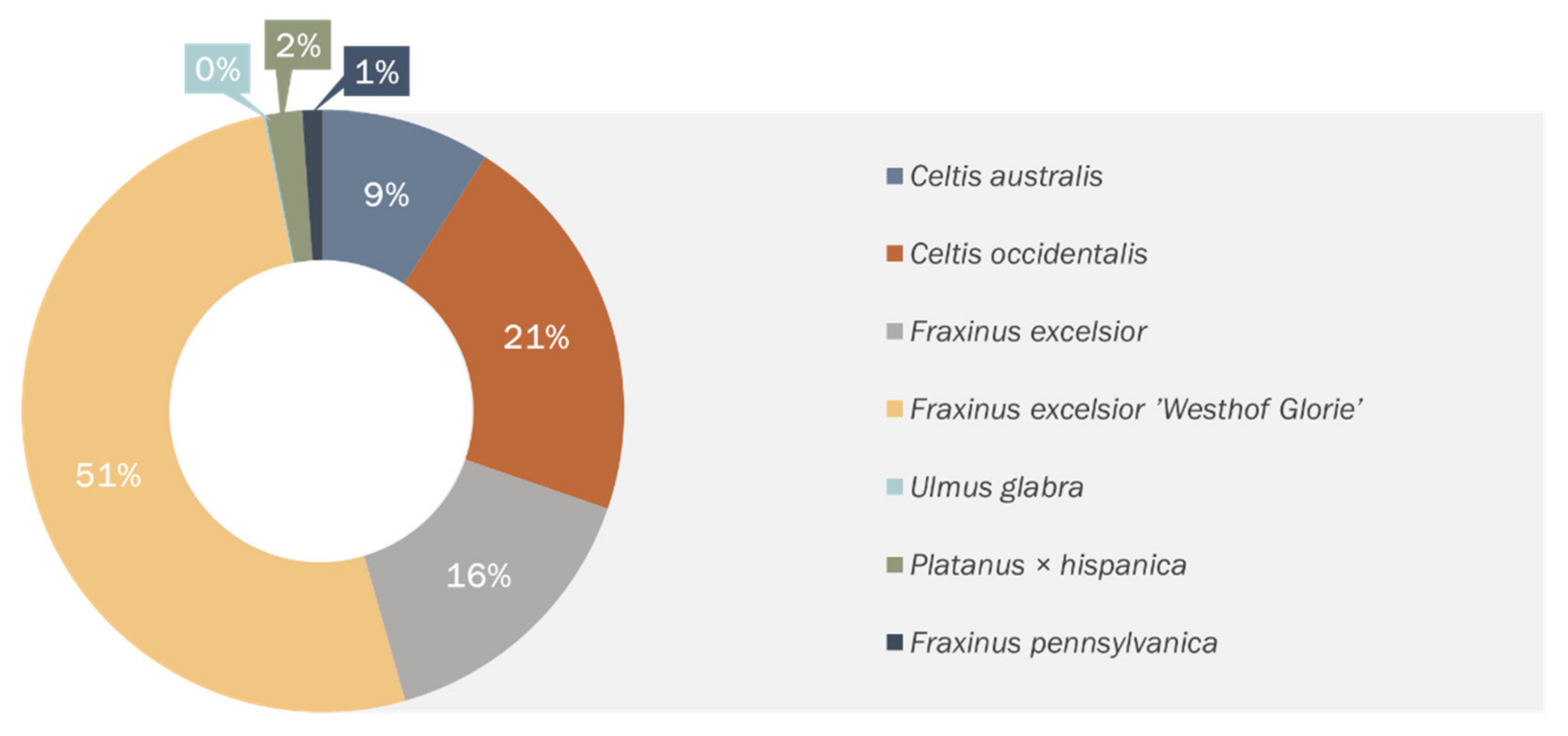
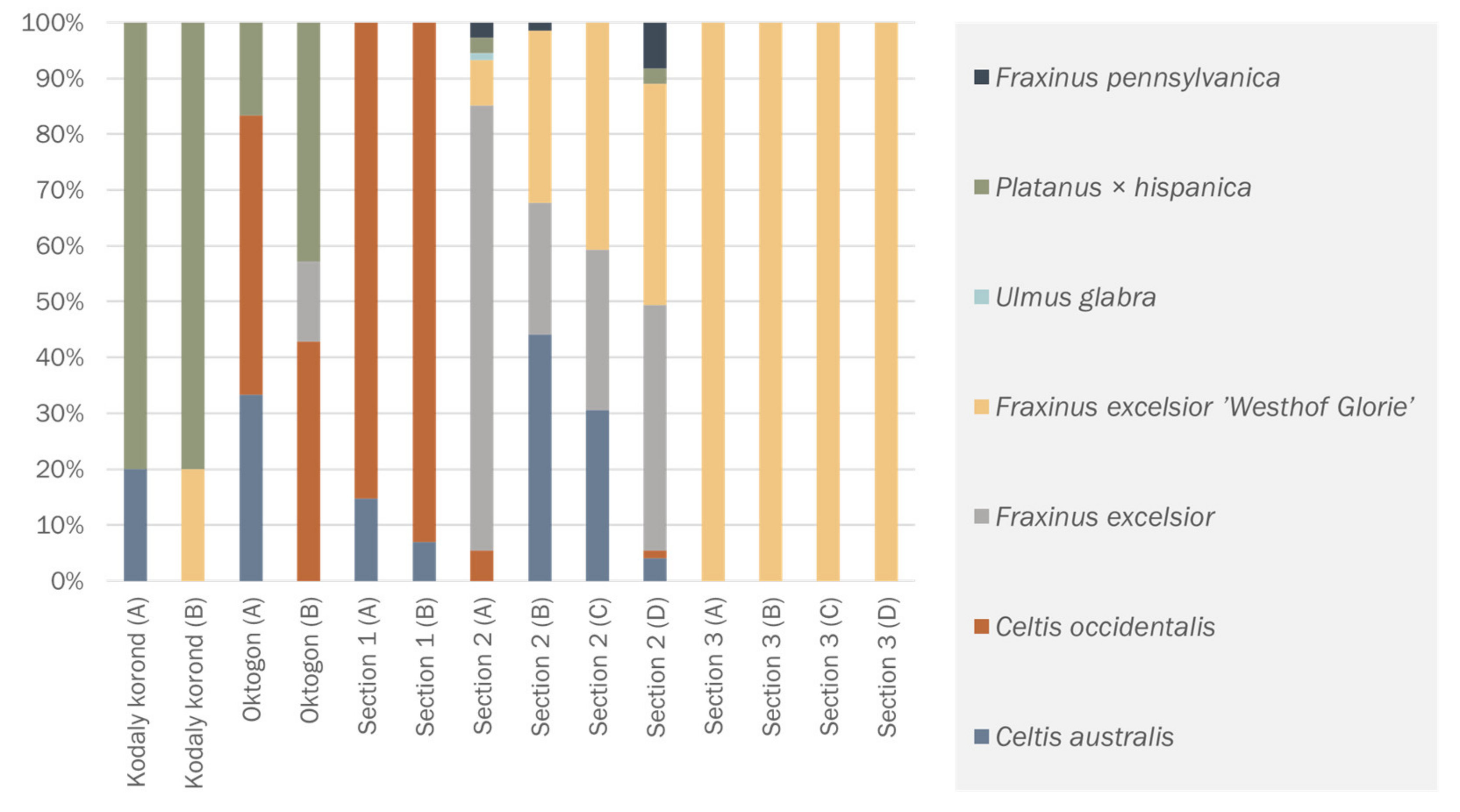



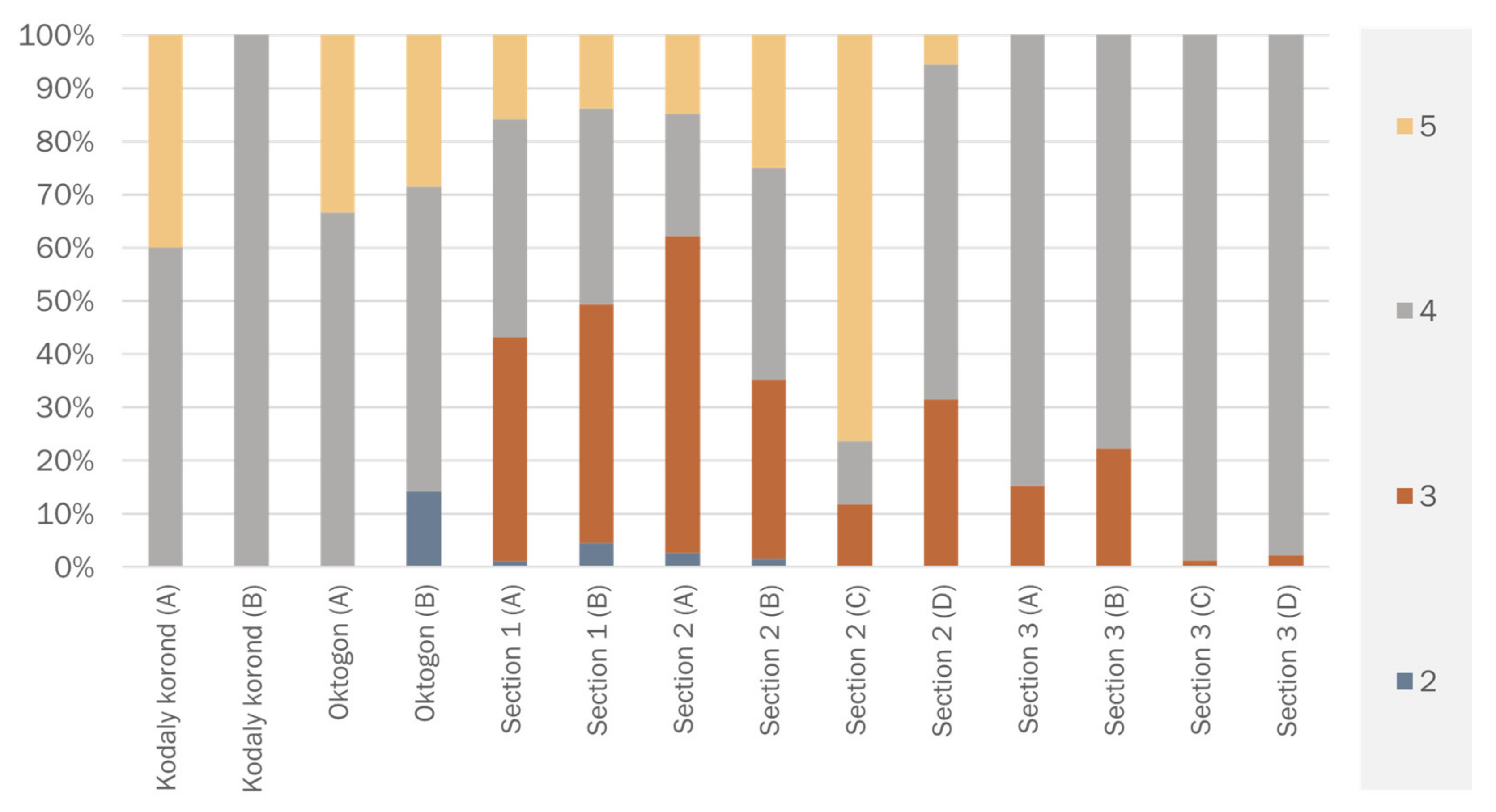

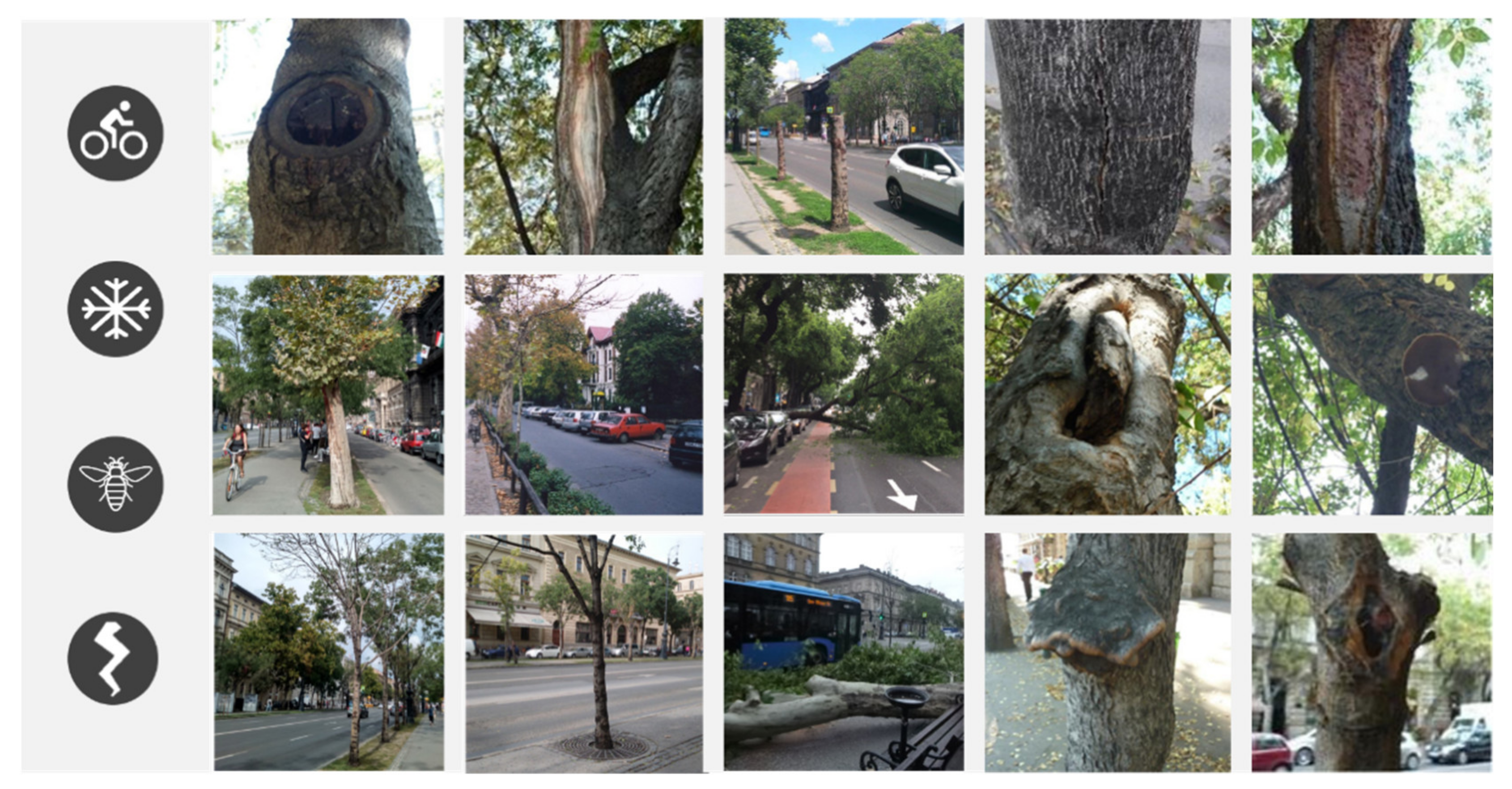
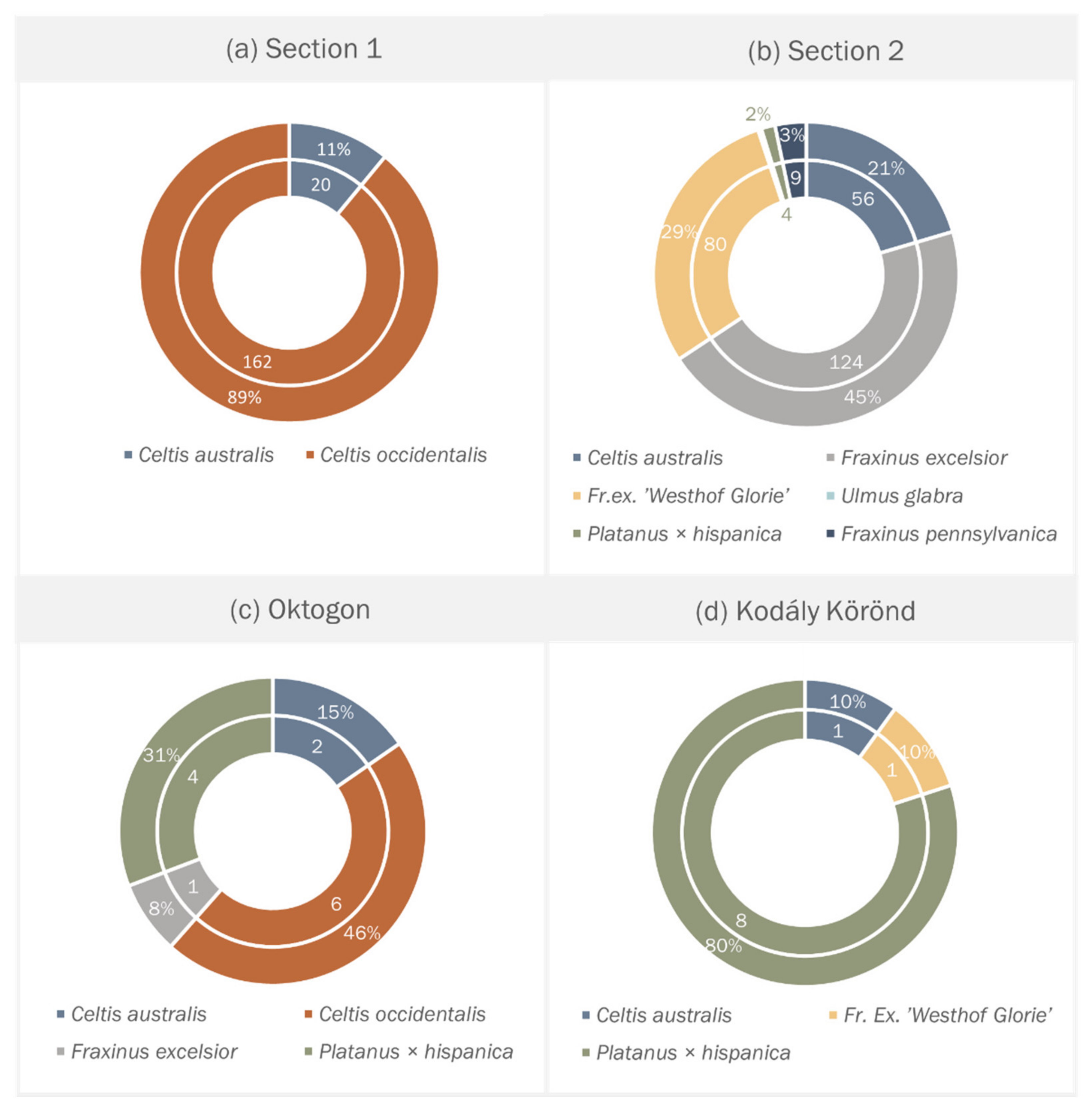

| Sections | Length (m) | Character | No. of Rows | No. of Trees | Species (Dominant in Bold) |
|---|---|---|---|---|---|
| I. | 844 | closed rows installation, no service road and walkway, trees in tree pits, opposite plantations | 1 × 1 | 182 | Celtis australis, Celtis occidentalis |
| II. | 563 | closed rows installation, service road and walkway, trees in the green bar, alternate plantations (triple bond) | 2 × 2 | 274 | Fraxinus excelsior, F. ex. ‘Westhof’s Glorie’, F. pennsylvanica, Platanus × hispanica, Ulmus grabra, Celtis australis |
| III. | 656 | closed rows installation, service road and walkway, trees in the green bar, alternate plantations (triple bond) | 2 × 2 | 337 | F. ex.‘Westhof’s Glorie’ |
| Oktogon | plantation in tree pits, along the four square borders | 1 × 1 | 13 | Celtis australis, Celtis occidentalis, Platanus × hispanica | |
| Kodály Körönd | the plantation is in the green area on green islands | 1 × 1 | 10 | Platanus × hispanica, Celtis occidentalis |
Publisher’s Note: MDPI stays neutral with regard to jurisdictional claims in published maps and institutional affiliations. |
© 2021 by the authors. Licensee MDPI, Basel, Switzerland. This article is an open access article distributed under the terms and conditions of the Creative Commons Attribution (CC BY) license (https://creativecommons.org/licenses/by/4.0/).
Share and Cite
Szilágyi, K.; Lahmar, C.; Rosa, C.A.P.; Szabó, K. Living Heritage in the Urban Landscape. Case Study of the Budapest World Heritage Site Andrássy Avenue. Sustainability 2021, 13, 4699. https://doi.org/10.3390/su13094699
Szilágyi K, Lahmar C, Rosa CAP, Szabó K. Living Heritage in the Urban Landscape. Case Study of the Budapest World Heritage Site Andrássy Avenue. Sustainability. 2021; 13(9):4699. https://doi.org/10.3390/su13094699
Chicago/Turabian StyleSzilágyi, Kinga, Chaima Lahmar, Camila Andressa Pereira Rosa, and Krisztina Szabó. 2021. "Living Heritage in the Urban Landscape. Case Study of the Budapest World Heritage Site Andrássy Avenue" Sustainability 13, no. 9: 4699. https://doi.org/10.3390/su13094699
APA StyleSzilágyi, K., Lahmar, C., Rosa, C. A. P., & Szabó, K. (2021). Living Heritage in the Urban Landscape. Case Study of the Budapest World Heritage Site Andrássy Avenue. Sustainability, 13(9), 4699. https://doi.org/10.3390/su13094699







